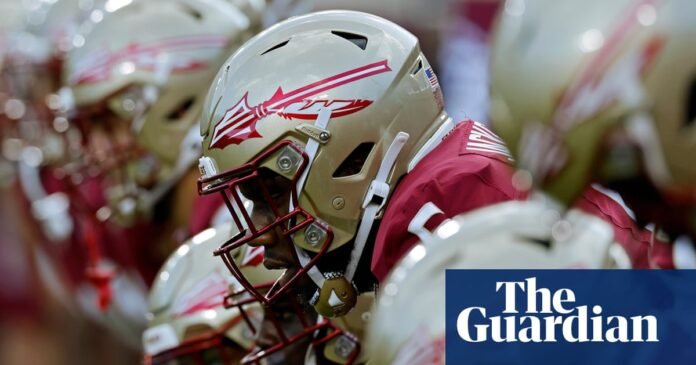Revenue sharing is now a feature of college athletics. Thanks to the house settelement signed in May, schools are permitted to spend $20.5m annually across sports, including through expanded scholarships and direct payments (of which it appears football will generally receive approximately 75%). This would seem to mitigate the longstanding problem of exploitation in college football.
However, in a sport still defined by extreme injury, recently disclosed provisions in the new Florida State University (FSU) revenue-sharing contract show that schools appear to simply be finding new ways to extract value from players, as ever at startling personal cost.
Per a CBS Sports report, the new FSU contract being distributed to football players reads, in part, “the following circumstances create a breach of contract by Student-Athlete: Student-Athlete experiences any illness or injury which is serious enough to affect the value of the rights granted to [school] under this Agreement.”
In other words: If a player gets injured, the school has leverage to cancel the deal.
Darren Heitner, adjunct law professor at the University of Florida and University of Miami, and an expert on college sports’ name, image and likeness (NIL) deals, was stunned by what he found upon reading the contracts.
“I take no issue with the drafter of a contract creating a document that leans in favor of the drafting party. In fact, that’s expected,” he told us. “However, there is a problem with a contract when it is so unfair, one-sided, and oppressive that it shocks the conscience.
“Reviewing the terms and considering that sometimes 17-year-olds with no legal counsel will be asked to sign on the dotted line, my takeaway is that this rises to the level of unconscionability unless thoroughly negotiated. I have reviewed dozens of revenue-sharing agreements and none compare.”
In a statement given to CBS Sports, FSU said in part that “Each individual situation will be unique and the hypotheticals are impossible to predict. However, we are committed to continuing to provide an elite experience for our student-athletes in all aspects of their collegiate career.”
Injury, of course, is an inherent feature of college football. In our recent book The End of College Football: On the Human Cost of an All-American Game we observe that every 2.6 years of participation in football doubles the chances of contracting the degenerative brain disorder chronic traumatic encephalopathy (CTE) and that 91 percent of American college football players’ brains examined in a pivotal Boston University study displayed neuropathology consistent with CTE. Similarly, participation in football likely increases the chances of developing Parkinson’s disease by 61 percent compared to athletes in other organized sports (and that risk is 2.93 times greater at the college/pro level).
In the book, we interviewed twenty-five former big-time college football players about their experiences in the sport. Many of those players suffered extremely debilitating injuries that caused them to lose seasons or even end careers, including knee reconstructions, torn AC joints, neck surgeries, torn achilles tendons, and countless concussions.
One player told us, “Before I got to college, never had an injury. By the time I left college, I had a medical record book of over six hundred pages. From rehab notes, surgery notes, to MRIs. I had over twelve MRIs total, five knee surgeries. This was while I was playing. . . . Later I found out that I had four torn labrum[s]. So I have a torn labrum on both shoulders, torn labrum on both hips.”
Thus, the question of players being relieved of their contractually agreed upon compensation as a consequence of injury is hardly academic. It will happen, and to many.
“I think the recently revealed contract details from Florida State exemplifies the current attitude of university officials who have completely lost sight of their jobs as educators,” former UCLA and NFL player Chris Kluwe told us. “They view college athletes (and students) as a product to be bought and sold and not human beings, which runs contrary to everything the education system should be.
“In a sport like football where athletes are predominately black and in a state like Florida where the current government seems intent on returning to the Antebellum Era, the fact school officials feel the need to include severe language curtailing players’ rights to the product of their labor is intensely concerning, and highlights the need for a college players union to protect athletes from would-be modern day plantation owners.”
The situation is compounded by the fact that universities don’t provide long-term health insurance to the players, leaving them to bear all the associated costs of their physical hardship. One player we spoke to for the book actually told us that “Long term, just strictly financially … it will have [ended up], like I paid money to play college football.”
Until such time as there are genuine occupational health and safety protections befitting a profession with such profound inherent dangers, it’s clear that the sport is not actually entering a more humane era. The House Settlement has ushered in little more than a new modality for the same old exploitation and harm.


























